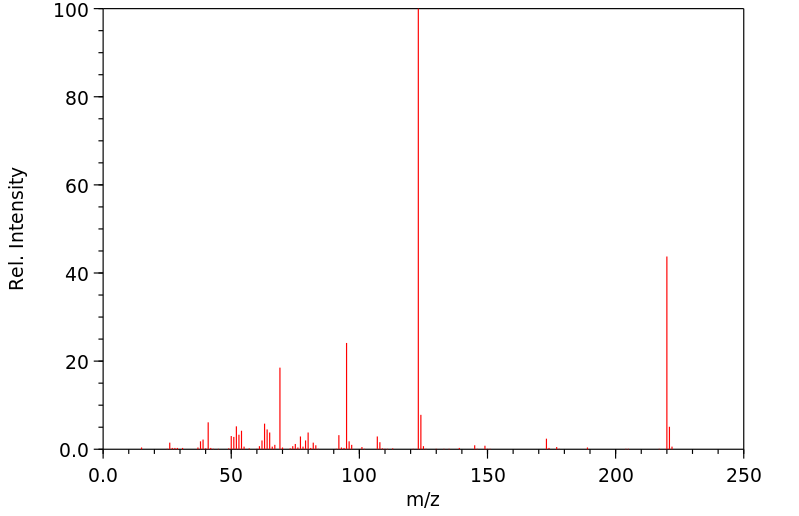p-methoxyphenyl trifluoroacetate | 5672-87-7
中文名称
——
中文别名
——
英文名称
p-methoxyphenyl trifluoroacetate
英文别名
Acetic acid, trifluoro-, p-methoxyphenyl ester;(4-methoxyphenyl) 2,2,2-trifluoroacetate
CAS
5672-87-7
化学式
C9H7F3O3
mdl
——
分子量
220.148
InChiKey
USKCDUZMASNBCQ-UHFFFAOYSA-N
BEILSTEIN
——
EINECS
——
-
物化性质
-
计算性质
-
ADMET
-
安全信息
-
SDS
-
制备方法与用途
-
上下游信息
-
文献信息
-
表征谱图
-
同类化合物
-
相关功能分类
-
相关结构分类
物化性质
-
保留指数:1111
计算性质
-
辛醇/水分配系数(LogP):2.7
-
重原子数:15
-
可旋转键数:3
-
环数:1.0
-
sp3杂化的碳原子比例:0.22
-
拓扑面积:35.5
-
氢给体数:0
-
氢受体数:6
SDS
反应信息
-
作为反应物:描述:p-methoxyphenyl trifluoroacetate 在 sodium azide 作用下, 以 二甲基亚砜 、 苯 为溶剂, 反应 7.0h, 生成 N-
-imidophosphorsaeure-triethylester 参考文献:名称:Zwierzak, Andrzej, Phosphorus, Sulfur and Silicon and the Related Elements, 1993, vol. 75, # 1-4, p. 51 - 54摘要:DOI: -
作为产物:描述:2,2,2-三氟-4-甲氧基乙酰苯 在 六氟异丙醇 、 间氯过氧苯甲酸 作用下, 以 phosphate buffer 、 二氯甲烷 为溶剂, 反应 0.17h, 以99%的产率得到p-methoxyphenyl trifluoroacetate参考文献:名称:α氟化酮选择性Baeyer-Villiger氧化的新发现;合成α-氟代酯的新方法摘要:被有效地用α-氟化酮的拜尔-维利格氧化制备α-氟化酯米氯过苯甲酸(米温和条件下-CPBA)。酯的产率受酮的芳基上的溶剂,碱和取代基的选择影响。在室温下,使用1,1,1,3,3,3-六氟-2-丙醇(HFIP)与CH 2 Cl作为助溶剂,在10分钟至12小时内,用m -CPBA几乎定量地氧化了4-甲氧基苯基取代的氟代酮。2(1:1,v / v)和水性缓冲液(KH 2 PO 4-NaOH,pH 7.6)作为添加剂。α-氟代酮的氧化反应速率高于相应的非氟代酮的氧化反应速率。氟甲基芳基酮的α位上的氟原子增强了Baeyer-Villiger氧化反应的活性。DOI:10.1016/s0040-4020(03)00047-4
文献信息
-
Electron-Withdrawing Substituents Decrease the Electrophilicity of the Carbonyl Carbon. An Investigation with the Aid of <sup>13</sup>C NMR Chemical Shifts, ν(CO) Frequency Values, Charge Densities, and Isodesmic Reactions To Interprete Substituent Effects on Reactivity作者:Helmi Neuvonen、Kari Neuvonen、Andreas Koch、Erich Kleinpeter、Paavo PasanenDOI:10.1021/jo020121c日期:2002.10.1electron-withdrawing substituents destabilize the carbonyl derivatives investigated. So, a significant ground-state destabilization of carboxylic acid esters, and carbonyl compounds in general, due to the decreased resonance stabilization, is proposed as a novel concept to explain both the increase in their reactivity and the changes in the chemical shifts and carbonyl frequencies induced by electron-withdrawing
-
The Trifluoroacetate Method of Peptide Synthesis. I. The Synthesis and Use of Trifluoroacetate Reagents作者:Shumpei Sakakibara、Noriyoshi InukaiDOI:10.1246/bcsj.38.1979日期:1965.11thiophenol and N-hydroxyimide derivatives, which are known as hydroxylic partners of various active carboxylic acid ester, have been synthesized, and it has been found that they are good reagents for the preparation of the respective active esters of acylamino acids by the ester-exchange reaction in pyridine. The new method is especially effective in the preparation of p-nitrophenyl, 2,4,5-trichlorophenyl
-
一种三氟乙酰丙酮的制备方法
-
A Practical and Highly Efficient Synthesis of α-(Trimethylsilyl)-difluoroacetates作者:Hideki Amii、Takeshi Kobayashi、Kenji UneyamaDOI:10.1055/s-2000-8718日期:——An efficient method for the gram scale preparation of α-(trimethylsilyl)difluoroacetates is described. The key step involves Mg(0)-promoted selective C-F bond cleavage of readily available trifluoroacetates.
-
Reactions of the readily accessible electrophile, trifluoroacetyl triflate: a very reactive agent for trifluoroacetylations at oxygen, nitrogen, carbon, or halogen centers作者:T. R. Forbus、S. L. Taylor、J. C. MartinDOI:10.1021/jo00228a002日期:1987.9
表征谱图
-
氢谱1HNMR
-
质谱MS
-
碳谱13CNMR
-
红外IR
-
拉曼Raman
-
峰位数据
-
峰位匹配
-
表征信息
同类化合物
马来酰亚胺四聚乙二醇CH2CH2COOPFPESTER
马来酰亚胺六聚乙二醇CH2CH2COOPFPESTER
马来酰亚胺-酰胺-PEG8-四氟苯酚酯
马来酰亚胺-四聚乙二醇-五氟苯酯
马来酰亚胺-三聚乙二醇-五氟苯酚酯
靛酚乙酸酯
阿立哌唑标准品002
间硝基苯基戊酸酯
间氯苯乙酸乙酯
间乙酰苯甲酸
钾4-乙酰氧基苯磺酸酯
酚醛乙酸酯
邻苯二酚二乙酸酯
邻甲苯基环己甲酸酯
邻甲氧基苯乙酸酯
辛酸苯酯
辛酸对甲苯酚酯
辛酸五氯苯基酯
辛酸-(3-氯-苯基酯)
辛酰溴苯腈
苯酰胺,3,4-二(乙酰氧基)-N-[6-氨基-1,2,3,4-四氢-1-(4-甲氧苯基)-3-甲基-2,4-二羰基-5-嘧啶基]-
苯酚-乳酸
苯酚,4-异氰基-,乙酸酯(ester)
苯酚,4-[(四氢-2H-吡喃-2-基)氧代]-,乙酸酯
苯酚,3-(1,1-二甲基乙基)-,乙酸酯
苯酚,2-溴-3-(二溴甲基)-5-甲氧基-,乙酸酯
苯甲醇,4-(乙酰氧基)-3,5-二甲氧基-
苯甲酸,4-(乙酰氧基)-2-氟-
苯氧基氯乙酸苯酯
苯基金刚烷-1-羧酸酯
苯基氰基甲酸酯
苯基庚酸酯
苯基庚-6-炔酸酯
苯基己酸酯
苯基呋喃-2-羧酸酯
苯基吡啶-2-羧酸酯
苯基十一碳-10-烯酸酯
苯基乙醛酸酯
苯基乙酸酯-d5
苯基丙二酸单苯酯
苯基丙-2-炔酸酯
苯基丁-2,3-二烯酸酯
苯基4-乙基环己烷羧酸
苯基3-乙氧基-3-亚氨基丙酸盐
苯基2-(苯磺酰基)乙酸酯
苯基2-(4-甲氧基苯基)乙酸酯
苯基2-(2-甲氧基苯基)乙酸酯
苯基2-(2-甲基苯基)乙酸酯
苯基-乙酸-(2-甲酰基-苯基酯)
苯基-乙酸-(2-环己基-苯基酯)







